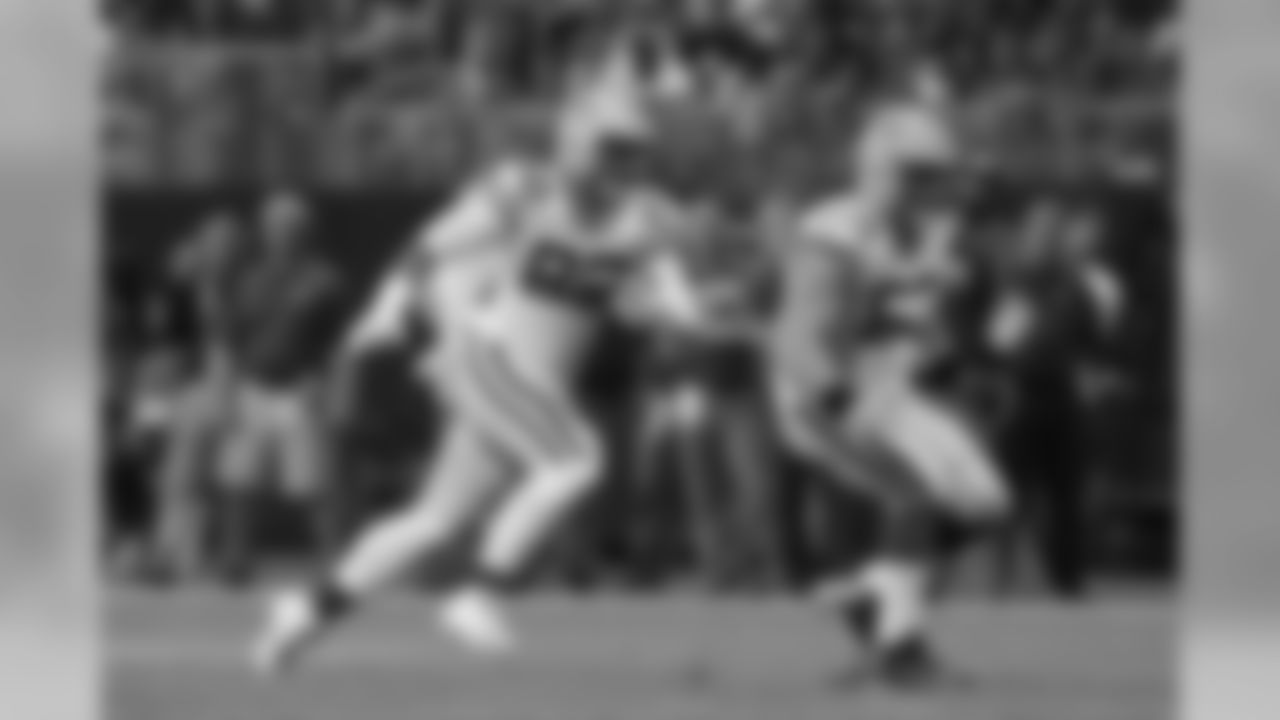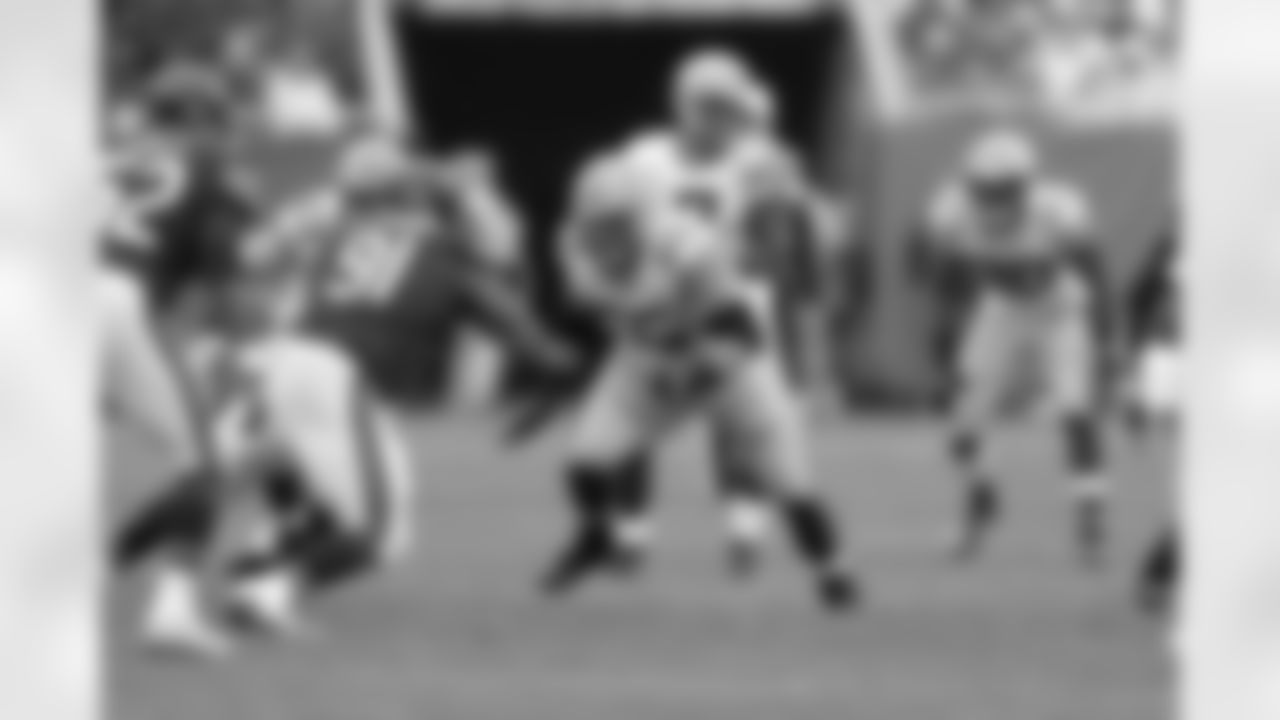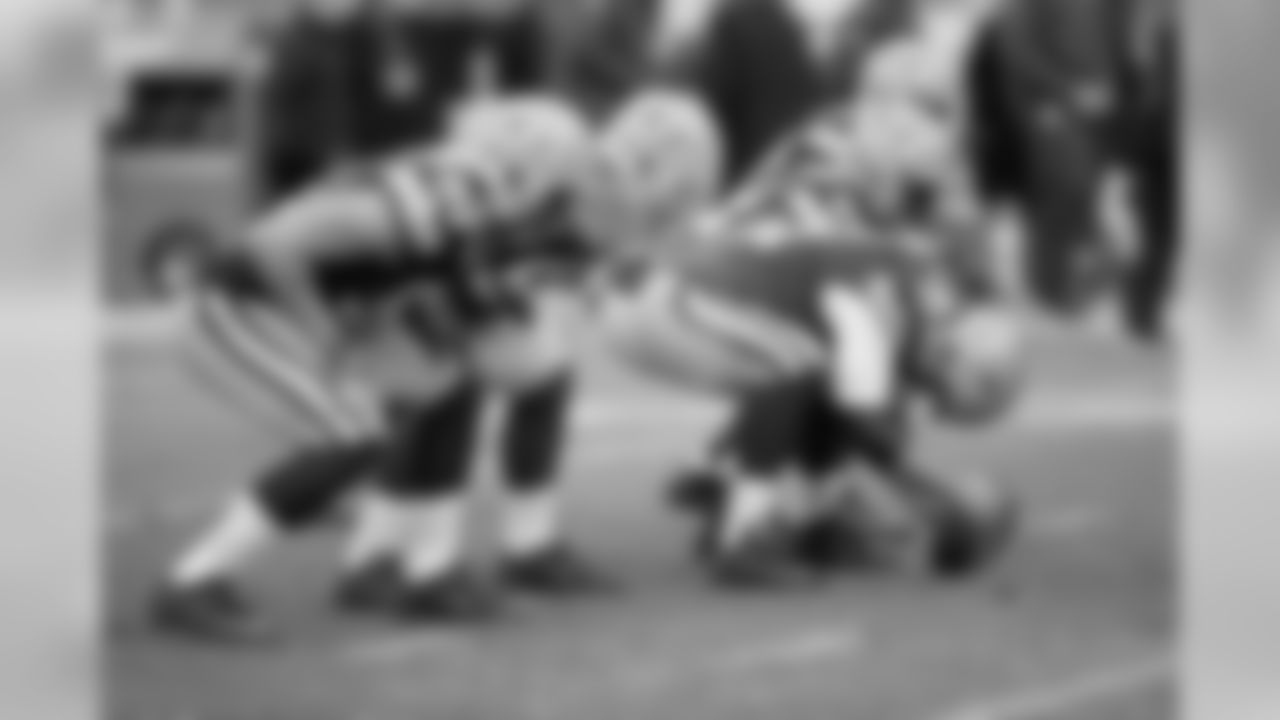On Sunday, the Tampa Bay Buccaneers will head to Green Bay to renew an old NFC Central rivalry. The Buccaneers and Packers will be meeting for the 54th time, and Tampa Bay will attempt to get its first win at Lambeau Field since 2005 (more on the Bucs-Packers series history). Both teams are hanging on to the fringes of the NFC playoff hunt.
To get their second road win of the season, the Buccaneers will need to make sure Brett Hundley's big-play production last Sunday night in Pittsburgh was an aberration and not a big step forward for Aaron Rodgers' current replacement. Tampa Bay's offense will be most concerned with edge-rusher Nick Perry and middle-of-the-line disruptor Mike Daniels. Here's a closer look at the challenges the Buccaneers will face on Sunday when they take on the Packers.
HEAD COACH

Mike McCarthy became the 14th head coach in Packers history in 2006, and in the 12 seasons since Green Bay has a .639 winning percentage, better than every team except New England and Pittsburgh. The Packers won the NFC South in six of his first 11 seasons at the helm and took home the Lombardi Trophy at the end of 2010, his fifth season in charge.
Packers history includes such luminary head coaches as Vince Lombardi, Forrest Gregg, Bart Starr and Mike Holmgren, but only Curly Lambeau has more victories as Green Bay's leader than McCarthy's 119. If the Packers, currently sitting at 5-6, fail to get on the right side of that ledger it will mark just the second time the team has finished with a losing record under McCarthy's watch. The Packers won 114 games from 2006-16, which is tied for the third most any head coach has logged through his first 11 seasons.
A look at the Packers' projected starters, according to the team's website.

QB Brett Hundley

RB Jamaal Williams

WR Jordy Nelson

WR Randall Cobb

TE Richard Rodgers

C Corey Linsley

OT Justin McCray

G Lane Taylor

OT David Bakhtiari

G Jahri Evans

DT Mike Daniels

DE Dean Lowry

DT Kenny Clark

LB Clay Matthews

LB Blake Martinez

LB Nick Perry

LB Jake Ryan

CB Davon House

CB Damarious Randall

S Ha Ha Clinton-Dix

S Morgan Burnett

K Mason Crosby

P Justin Vogel

KR/PR Trevor Davis

LS Brett Goode
The Packers gave McCarthy his first head coaching job at any level in 2006. He came directly from a one-year stint as the offensive coordinator for the San Francisco 49ers and inherited a team that had finished 4-12 the season before. McCarthy also inherited QB Brett Favre and eventually saw his team transition to another MVP quarterback in Aaron Rodgers. It is most likely the presence of those two Hall of Fame-bound passers that keep McCarthy from being granted sufficient credit in some circles, but it's worth noting that he guided the team through that Favre-to-Rodgers transition and only suffered one non-playoff season in the process.
Obviously, Green Bay's victory in Super Bowl XLV is the pinnacle of McCarthy's coaching career. But he has been associated with a playoff team in 13 of his 24 full NFL seasons while only enduring a losing season on four occasions. He and New England's Bill Belichick are the only two NFL head coaches who have led their team to the playoffs in each of the last eight years.
A Pittsburgh native, McCarthy began his coaching career in 1987 as a graduate assistant at Fort Hays State. That led a stint at Pitt, where he eventually became the quarterbacks coach, which set him on course for the rest of his coaching career. He made it to the NFL in 1993 as a quality control coach under Marty Schottenheimer in 1993. Again, he moved from that post into coaching quarterbacks, which he did for four seasons in Kansas City. McCarthy's first stint in Green Bay was as the quarterbacks coach in 1999 during Ray Rhodes one year at the Packers' helm, after which Jim Haslett hired him to be the offensive coordinator in New Orleans. He worked that job for five seasons, and in 2000 he was named the NFC Assistant Coach of the Year by USA Today.
OFFENSE

Green Bay's offense is obviously a different animal with Aaron Rodgers on the sideline. With the two-time league MVP on the field, Green Bay averaged 24.5 points per game through the first six weeks to rank 10th in the NFL. Since, with the untested Brett Hundley doing his best to fill in for Rodgers, the Packers have averaged 17.0 points per contest, ranking 25th in the NFL.
The Buccaneers will be facing that latter offense, as Rodgers is still a couple weeks away from a potential return from injured reserve, though it should be noted that Hundley and the Packers are coming off a productive 28-point outing in a narrow loss at Pittsburgh last Sunday night. Hundley threw three touchdown passes in that game, all of them 39 yards or longer, against no interceptions. That came a week after those numbers were flipped – zero TDs and three picks – in a shutout loss to Baltimore at Lambeau Field.
Hundley has had his ups and downs as a starter, with a 5-7 TD-INT ratio and a 73.3 overall passer rating, but he is a tough competitor with the arm to make downfield throws when needed, even on the run. Hundley's feet are an asset; he ran quite a bit at UCLA and has 103 yards and two touchdowns on the ground for the Packers this year. He has also proven effective when scrambling out of the pocket, something Green Bay receivers are used to from playing with Rodgers. That said, the Packers' offense is missing its usual big-play element – or was until the Steelers game – ranking 24th in the league in completions of 20-plus yards and 26th in passer rating on balls thrown more than 20 yards in the air. The Packers were tied for sixth in big passing plays last year and have ranked no lower than 12th in any year in which Rodgers has been at the helm of the offense.
Hundley's favorite target has been wide receiver Davante Adams, the only one of the Packers' wideouts whose numbers have remained fairly consistent since Rodgers went down. In fact, Adams' numbers – 55 catches for 702 yards and seven touchdowns – are nearly identical to those of the Bucs' top receiver, Mike Evans. Adams is the Packers' fastest receiver and he's good at hauling in contested passes. Jordy Nelson, one of the NFL's top touchdown-makers, has six scores this season but all of them came from Rodgers' hand. Nelson averaged 79 yards per game or better each of the last three seasons and has a career per-catch average of 14.5, but those numbers are down to 35.7 and 10.3, respectively, this year. In fact, none of Green Bay's top six pass-catchers has a per-catch average better than 12.8.
Pictures from the Buccaneers' practice on Wednesday.

QB Jameis Winston

CB Brent Grimes

HC Dirk Koetter

WR Freddie Martino

QB Jameis Winston

RB Charles Sims and WR Bobo Wilson

QB Jameis Winston

QB Jameis Winston

QB Ryan Fitzpatrick

QB Jameis Winston

TE Antony Auclair

RB Peyton Barber

RB Jacquizz Rodgers

RB Deji Olatoye

QB Jameis Winston

P Bryan Anger

OT Donovan Smith and RB Charles Sims

G J.R. Sweezy, C Joe Hawley and QB Jameis Winston

TE O.J. Howard

WR Freddie Martino

WR Adam Humphries

WR Mike Evans

CB Maurice Fleming

WR Freddie Martino

RB Jacquizz Rodgers

CB Brent Grimes

K Patrick Murray

DE Robert Ayers

C Evan Smith

G/T Kevin Pamphile and LB Kendell Beckwith

OT Leonard Wester

DE William Gholston

DE Will Clarke and OT Givens Price

TE O.J. Howard

WR Bobo Wilson and DB Ryan Smith

LB Adarius Glanton

WR Bobo Wilson

OT Donovan Smith

RB Peyton Barber

HC Dirk Koetter and QB Jameis Winston
Randall Cobb isn't quite the dynamic weapon he was during his peak years but he is still a versatile and dependable weapon who is occasionally used in tricky ways, such as on reverses or sweeps out of the backfield, or even as the quarterback in the Wildcat. Martellus Bennett was supposed to be a big producer out of the tight end spot but he's now a Patriot and the starter is Lance Kendricks, who has just 10 catches this year.
The running attack, which has had to cycle through a number of backs, has had results fitting with the offense as a whole, producing relatively well but lacking in big plays. The Packers get at least four yards on 47.7% of their runs, including 47.3% of the time on first downs, and those numbers rank third and fifth in the NFL, respectively. In addition, Packer runners rarely lose yards; Green Bay has just 12 rushes for negative yards all season, the fewest in the NFL. However, Green Bay has just 21 rushing plays of 10 or more yards, the fourth-fewest in the league.
Rookie Jamaal Williams has been the lead back of late, with both Ty Montgomery and Aaron Jones (another 2017 draft pick) sidelined with injuries. Though he's not as quick as Jones, who has a team-best 5.3 yards-per-carry average, Williams is stronger between the tackles and he's coming off his best game as a pro in Pittsburgh. A 54-yard rumble for a touchdown on a short pass helped him rack up 135 combined yards in that very close contest. Jones, the Packers leading rusher with 370 yards and three TDs, could potentially return to action this week, as could Montgomery. Montgomery, however, did not practice on Wednesday due to his wrist and rib injuries while Jones was at least a limited participant while trying to return from a knee ailment.
Due to that aforementioned success on first down, Green Bay leads the NFL in average yards needed on second down. That in turn has helped the Packers do well on third downs, where they are converting 40.6% of the time to rank 10th in the league. The Buccaneers need to find a way to stop that chain reaction on Sunday, because Hundley and the Packers are much better when they can shorten their third-down attempt. They rank 29th in the league on third-and-long (more than six yards) but 12th on third-and-medium and 14th on third-and-short. Green Bay has had 44 "short" third down tries (less than three yards), tied for the most in the NFL.
Green Bay runners have had to work with a shifting lineup in front of them, as injuries have hit the Packers' offensive line hard this year, particularly in the first half of the season. Green Bay started a different five-man combination in each of its first seven games and has used eight lineups in 11 games overall. That has surely contributed to less-than-ideal pass protection this year, with the Packers allowing 40 sacks, second-most in the league. Despite Hundley's above-average mobility, he has gone down 21 times on 205 pass plays. Left tackle David Bakhtiari, who missed four games early but has been back for the last six, is the rock of that front line, a reliable and technically-sound blocker on Hundley's blind side.
Hundley's mobility *has *likely been one of the reasons that Green Bay has performed very well in the red zone. In that part of the field, the Packers rank third in third-down conversion rate (52.9%), third in percentage of successful plays (52.6%) and second touchdown efficiency (67.7%). One other thing Green Bay's offense does very well: start the game off right. The Packers have scored 44 points on the first possessions of its game, the most in the NFL and more than double the league average.
DEFENSE

Green Bay's defense has had some injury issues, as well, though they still rank close to league average with 23.7 points allowed per game. Among those starters who have been sidelined at times are defensive linemen Mike Daniels and Kenny Clark, linebacker Clay Matthews and safety Morgan Burnett. Matthews and Clark both missed last Sunday's game in Pittsburgh.
Daniels has been healthy most of the season and is Green Bay's defensive linchpin. He plays a game similar to the one the Buccaneers just saw in Atlanta's Grady Jarrett – active, instinctive and disruptive. He's the interior penetrator in the Packers' 3-4 scheme, with Clark or recent replacement Quinton Dial playing the nose and Dean Lowry rushing from the strong side. Daniels has 3.5 sacks and a team-high eight quarterback hits.
Nick Perry, a 6-3, 270-pound linebacker who rushes off the weak side from a two-point stance in base downs, is the Packers' sack leader with seven, following his breakout 11-sack campaign in 2016. Clay Matthews isn't quite as dangerous of a pass-rusher as he was when he hit double digits in sacks in four of his first six seasons, but he still has stretches during which he is very disruptive. He has 3.5 sacks this year and has also broken up a pair of passes in coverage.
Linebackers Jake Ryan and Blake Martinez play in the middle of that 3-4 front and are the two primary run-stoppers. Martinez, in particular, is far and away the team's most productive tackler, with 98 stops, 44 more than the next man on the list, safety Ha Ha Clinton-Dix. Martinez has had 12 or more tackles in six different games this year, using defensive totals compiled by the Packers' staff.
Green Bay opponents are averaging 107.1 rushing yards per game and 3.8 yards per carry, though they have scored nine times on the ground. The Packers have allowed four or more yards on only 39.6% of their opponents rushing attempts, the ninth-best mark in the league. That doesn't seem to be influencing opposition play-calling, however, as Green Bay foes have run on 56.4% of their first-and-10 snaps, the 10th-highest percentage in the league. The Packers have been susceptible to the big play, allowing the fourth-most plays of 10 or more yards, the sixth-most plays of 20 or more yards and the sixth most completions of 20 or more yards.
Damarious Randall, a college safety now playing cornerback is the top pick artist in the secondary, leading the team with four interceptions and nine passes defensed. Randall starts opposite Davon House but moves into the slot when the Packers go to a nickel or dime, which they do quite frequently. In those situations, 6-3 rookie cornerback Kevin King comes in to play on the outside. King's size and physical play make him a good matchup for big receivers like Mike Evans, though he is currently playing with an injured shoulder, which adds a level of difficulty to some of his assignments.
The back half of the secondary is comprised of a pair of accomplished safeties in Clinton-Dix and Morgan Burnett. Clinton-Dix is smooth athlete who runs well, a play-maker and a good blitzer with 54 tackles, two tackles for loss, two interceptions and four passes defensed. His production is down a bit from 2016, when he went to the Pro Bowl in his third season. Burnett is a leader on the field, an instinctive player who is at his best in the box and often is employed essentially as a nickel linebacker in dime formations.
As noted above, Green Bay's secondary has shown some cracks this season and opposing quarterbacks have a combined 96.9 passer rating against the Packers. That's the seventh-worst mark in the NFL. Like the Buccaneers, the Packers have struggled to get off the field on third down, allowing a conversion rate of 42.1% that ranks 26th in the NFL. In contrast to their offense, the Packers' defense gets better, relative to the league, as third downs get longer. The Bucs will need to create short third downs, because Green Bay ranks sixth on third-and-long but 29th on third-and-medium and 25th on third-and-short. Due to those third-down conversions, the Packers' defense has forced three-and-outs on just 16.9% of opposing drives, the second-lowest percentage in the NFL.
The Packers' red zone success on offense is matched by that of their opponents. Inside the 20, Green Bay foes have a successful-play rate of 52.8% (30th in the NFL), a third-down conversion rate of 42.1% (26th) and a touchdown efficiency of 69.0% (30th). And if the Packers tend to start fast, so do their opponents; Green Bay has allowed a league-worst 34 points on the first drives of their games.
Green Bay's defense has snared one fewer interception (10-9) than their quarterbacks have thrown but the Packers still have a plus-five turnover ratio because they've been adept at getting the ball out of opposing hands. Green Bay opponents have fumbled 15 times and the Packers have recovered 10 of them, fourth-best in the NFL. The Buccaneers are one of three teams (also Chicago and Jacksonville) tied for first with 11 fumble recoveries.
SPECIAL TEAMS

Green Bay has had a lot more continuity at kicker than at punter in recent years. Mason Crosby has been handling placekicking duties for Green Bay since 2007, and the 2015-16 seasons were two of his best. He made 50 of 58 field goal tries (86.2%) over those two seasons combined, including five of seven from 50 yards and beyond. His accuracy has dipped a little in his 11th season, as Crosby has been good on 11 of 15 tries (73.3%) and only one of three from the 50-plus range.
Since the NFL moved the extra point back to the 15-yard line last year, Crosby has missed five of them in 74 tries. He also handles kickoffs for the Packers, who rank near the middle of the pack with a 55.1% touchback percentage. The Packers are also 25th in the league in kickoff coverage, averaging 24.0 yards allowed per runback, which factors into poor field position. Green Bay opponents start their drives on the 30.7-yard line, on average, which is the second worst mark in the NFL.
Meanwhile, Green Bay is on its third punter in the last three seasons. Handling the job this year is rookie Justin Vogel, an undrafted free agent out of the University of Miami. Vogel has performed well, particularly in terms of net average, with a mark of 42.2 yards per kick that ranks sixth in the NFL. Vogel's gross average of 44.9 is farther down in the rankings, but he has the third-lowest difference of any punter in the league between his gross and his net. That is the function of good hang time and a coverage unit that has held opposing return men to 5.3 yards per runback. Also greatly helping Vogel's net is the fact that he hasn't suffered a single touchback all season, versus 14 punts inside the 20.
Trevor Davis, a receiver drafted in the fifth round in 2016, has handled almost all of Green Bay's return duties, with a 9.6-yard average on 14 punt returns and a 22.5-yard average on 18 kickoff runbacks. Second-year safety Marwin Evans is the team's top cover man on special teams, with 10 kick-coverage stops.























